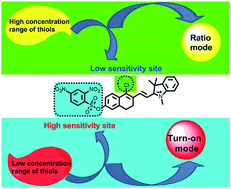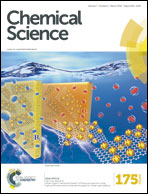Single near-infrared fluorescent probe with high- and low-sensitivity sites for sensing different concentration ranges of biological thiols with distinct modes of fluorescence signals†
Abstract
We describe a unique approach for the development of an interesting type of the fluorescent probes, which can show different modes of fluorescence signals to distinct concentration ranges of a target of interest. The key points for the design of the new type of the fluorescent probes include the judicious selection of the dye platforms and the corresponding high- and low-sensitivity sites. It is known that the normal concentrations of biological thiols have significant biological functions. However, up- or down-regulated concentrations of thiols may induce several diseases. Therefore, it is highly important to monitor the changes of thiol concentrations in living systems. Based on the proposed strategy, we engineer the novel NIR fluorescent probe, CHMC-thiol, which remarkably can display a turn-on signal to the low concentration range of thiols and a ratiometric response to the high concentration range of thiols for the first time. We anticipate that the intriguing strategy formulated herein will be widely useful for the development of concentration range-dependent fluorescent probes.

- This article is part of the themed collection: Top 50 Articles of 2016: Analytical, Biological and Medicinal Chemistry

 Please wait while we load your content...
Please wait while we load your content...